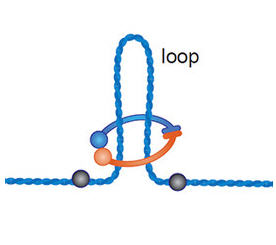Looping the Genome: how Cohesin does the Trick

Schematic illustration of the loop-extrusion mechanism (Copyright: IMP)
Twenty years ago, the protein complex cohesin was first described by researchers at the IMP. They found that its shape strikingly corresponds to its function: when a cell divides, the ring-shaped structure of cohesin keeps sister-chromatids tied together until they are ready to separate.
Apart from this important role during cell-divison, other crucial functions of cohesin have been discovered since – at the IMP and elsewhere. One of them is to help fold the DNA, which amounts to about two meters per nucleus, into a compact size by way of creating loops. “We think that the cohesin-ring clamps onto the DNA-strand to hold the loops in place”, says IMP-director Jan-Michael Peters whose team worked on the project.
The chromatin-loops are not folded at random. Their exact shape and position play an important role in gene regulation, as they bring otherwise distant areas into close contact. “For a long time, scientists were mystified by how regulatory elements – the enhancers – are able to activate distant genes. Now we think we know the trick: precisely folded loops allow enhancers to come very close to the genes they need to regulate”, says Peters. Research results point to cohesin as mediator of this process. Jan-Michael Peters and his team have already shown that the cohesin complex accumulates in areas where loops are formed.
Several scientists recently proposed a so-called “loop-extrusion mechanism” for the folding of chromatin. According to this hypothesis, cohesin is loaded onto DNA at a random site. The DNA strain is then fed through the ring-shaped complex until it encounters a molecular barrier. This element, a DNA-binding protein named CTCF, acts much like a knot tied in a rope and stops the extrusion-process at the correct position. Defined genome-sequences that were previously located far apart are now next to each other and can interact to regulate gene expression.
In NATURE online this week, IMP-researchers publish data that support the existence of such a mechanism. First author Georg Busslinger, a PhD-student in Jan-Michael Peters’ team, showed in mouse cells that cohesin is indeed translocated on DNA over long distances and that the movement depends on transcription, suggesting that this may serve as a ‘motor’.
“The loop extrusion hypothesis has opened up a whole new research area in cell biology and we will probably see many more papers published on this topic in the future”, comments Jan-Michael Peters. Understanding cohesin-function is also relevant from a medical perspective since a number of disorders, including certain cancers, are associated with malfunctions of the protein-complex.
Original Publication
Busslinger GA, Stocsits RR, van der Lelij P, Axelsson E, Tedeschi A, Galjart N und Peters J-M: Cohesin is positioned in mammalian genomes by transcription, CTCF and Wapl. Nature Advance Online Publication, 19 April 2017, http://rdcu.be/rsMu.
A News-Feature on the topic was published by NATURE simultaneously: http://www.nature.com/news/dna-s-secret-weapon-against-knots-and-tangles-1.21838
Illustration
An illustration can be downloaded and used free of charge in connection with this press release: https://www.imp.ac.at/news-media/downloads/
Caption: Schematic illustration of the loop-extrusion mechanism (Copyright: IMP)
About the IMP
The Research Institute of Molecular Pathology (IMP) in Vienna is a basic biomedical research institute largely sponsored by Boehringer Ingelheim. With over 200 scientists from 37 nations, the IMP is committed to scientific discovery of fundamental molecular and cellular mechanisms underlying complex biological phenomena. Research areas include cell and molecular biology, neurobiology, disease mechanisms and computational biology.
Contact
Heidemarie Hurtl
IMP Communications
Research Institute of Molecular Pathology
+43 (0)1 79730 3625
hurtl@imp.ac.at
https://www.imp.ac.at/news/detail/article/looping-the-genome-how-cohesin-does-th…
Media Contact
All latest news from the category: Life Sciences and Chemistry
Articles and reports from the Life Sciences and chemistry area deal with applied and basic research into modern biology, chemistry and human medicine.
Valuable information can be found on a range of life sciences fields including bacteriology, biochemistry, bionics, bioinformatics, biophysics, biotechnology, genetics, geobotany, human biology, marine biology, microbiology, molecular biology, cellular biology, zoology, bioinorganic chemistry, microchemistry and environmental chemistry.
Newest articles

NASA: Mystery of life’s handedness deepens
The mystery of why life uses molecules with specific orientations has deepened with a NASA-funded discovery that RNA — a key molecule thought to have potentially held the instructions for…

What are the effects of historic lithium mining on water quality?
Study reveals low levels of common contaminants but high levels of other elements in waters associated with an abandoned lithium mine. Lithium ore and mining waste from a historic lithium…

Quantum-inspired design boosts efficiency of heat-to-electricity conversion
Rice engineers take unconventional route to improving thermophotovoltaic systems. Researchers at Rice University have found a new way to improve a key element of thermophotovoltaic (TPV) systems, which convert heat…



